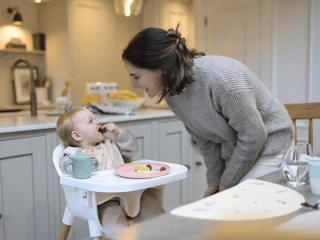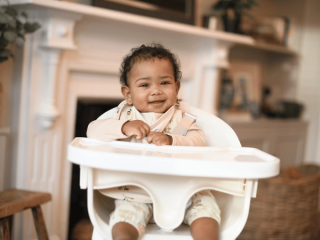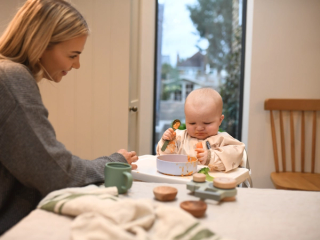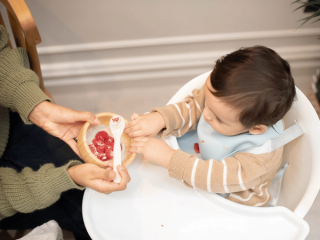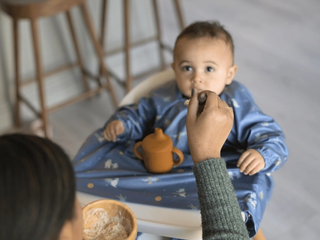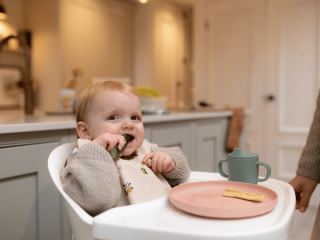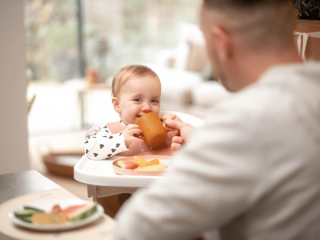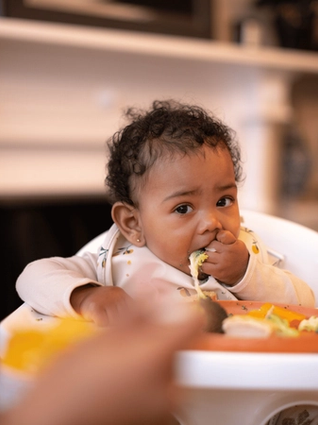
- Home
- Advice Hub
- Baby
- Weaning
- Finger Foods: Safety And How To Maximise Nutrition
Finger foods: Safety and how to maximise nutrition
Offering your baby finger foods can feel scary at first; but it’s one of those skills that they have to learn. Luckily for you we are here to give you guidance on how to offer foods in the safest way possible.
Finger foods
In the UK the recommendation is to offer finger foods to your baby from around the age of 6 months, which for many parents can feel quite daunting as the risk of choking feels higher. We know from the research that if finger foods are offered safely they do not pose more of a choking risk; but it’s important these are given in the right way.
Finger foods are recommended as they teach your baby how to put food into the mouth, biting off the right amount and chewing lumps too. They also offer the opportunity for your baby to explore their food – the feel, smell, and look of it in its whole form, which is an important part of learning to enjoy them.
Getting started
Offering your baby finger foods can feel scary at first, but it’s one of those skills that they must learn. Luckily for you, we are here to give you guidance on how to offer foods in the safest way possible.
We aren’t going to list lots of different foods because we all eat such different things and the possibilities are endless. Giving a list can feel easier for you at first but can end up being more of a hinderance as you tend to stick with what’s on the list. Instead here are three ways to ensure that finger foods are safe for your baby:
- Give foods that are around the size of your index finger. Foods should be long enough that when your baby grabs it with their fist there is enough sticking out of the top for them to eat.
- Foods should be soft enough to easily squish between your fingers. This means that when your baby squashes the food between their gums or against the roof of their mouth with their tongue it will mash down enough to be swallowed.
- Make sure foods are soft enough that if you bend them they don’t snap. Anything that snaps is likely to be too hard for your baby to chew down in their mouth and will therefore be a choking hazard. Pieces softly breaking off is ok, that will happen as they put food in their mouth.
Our advice is really to get adventurous and try to think of all the different foods your baby can eat. If you need some inspiration, here are a few tips to get you started with your finger food journey:
- Don’t feel it has to be complicated – you don’t need to be baking baby muffins and croquettes every day. Remember, weaning is all about your baby learning to enjoy normal family foods so actually, it can be better to put out some omelette slices and broccoli as these are foods your child needs to learn about.
- Roll wet finger foods in our baby rice. It will give it more grip for your baby to hold on to.
- Use a crinkle cutter to cut vegetables and other foods. This gives more of a grip for your baby to hold onto. That’s especially useful when they are dribbling and the food gets a bit wet and slippery.
Try to offer as much variety as you can. This doesn’t always mean having to cook totally new dinners, it can be as simple as just varying the bread you offer or the pasta shapes you use. Well cooked pasta is a great easy finger food for babies, you can vary up the sauce. Our puree range make great pasta sauces and are an easy way to offer a varied meal to your baby whilst still giving them independence and a great learning experience.
Maximising nutrition
When offering food, it’s good to think ‘how can I make this a balanced option for my baby’. It doesn’t need to be complicated, but a little bit of thought can make the difference between an average and great meal option.
- Try to offer finger foods from all the food groups, not just fruits and vegetables. Vegetables and soft or cooked fruits work well at first but you don’t have to stick to just these. Toast fingers, well cooked pasta, omelette, porridge fingers, fish cakes, crumpets made into eggy bread are some good options to get you started.
- Roll wet or slippery finger foods in our baby porridge or something like ground flaxseed.
- You can use finger foods as cutlery. Help your baby to dip finger foods into their bowl and they can eat their food this way.
- Finally, try spreading the puree or mashed foods onto finger foods. Even when your baby hasn’t fully mastered taking bites and chewing they will be able to suck. Having nice flavours present is likely to encourage them to put more in and in turn they’ll become better at eating.
Advice & tips

Want to read more? Join the HiPP BabyClub for full access to this article.
As a BabyClub member, you'll get access to a range of exclusive benefits, including:
Monthly competitions
Discounts from our Partners
Expert advice tailored to your little one's age
Weaning recipes
HiPP shop discounts*
*10% off HiPP's online shop does not apply to our First Infant, Anti-Reflux or Comfort Formula Milk.
Important notice: Breastfeeding is best. Follow on milk should only be used as part of a mixed diet from 6 months. Talk to a healthcare professional.




